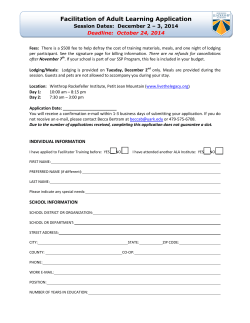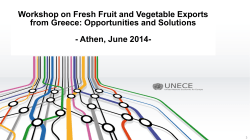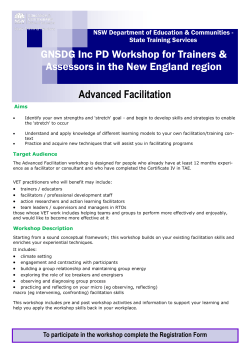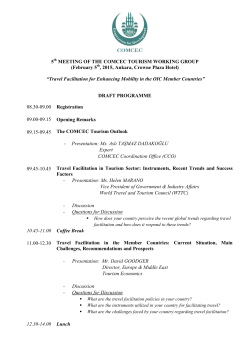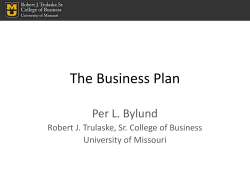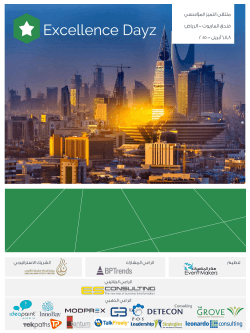
A portfolio for design Research and strategy
A portfolio for design Research and strategy My Story Research / Strategy Workshop Facilitation Prototyping / Developing Visual Design Published Works MY STORY Being an Entrepreneur & Learning Design Process I co-founded a design studio focusing on B&B branding years ago. Like other entrepreneurs, we saw an opportunity to provide our service to improve those businesses. Our studio was successful because every B&B business needed a website or other visual design products to thrive in this technology driven age. However, I knew web design services were not the best and the only answer to the challenges those business owners faced. I kept asking myself the same question: What can design do beyond making graphics and logos? How can we serve businesses with solutions for their sustainability? It wasn’t until I invested in a degree to study design processes that I found the answers to those questions and my passion for design. When I look back now, I find I have transformed my perspective from being a graphic designer to a design strategist. I believe design can not only make things more pleasant but also serve as a holistic approach to problem solving. I have been working on projects with startups and adopting the design process to identify problems, synthesize data, and visualize information. Now, years later, I am answering those questions here by practicing design to make a social impact. A business model’s current state mapping with a startup in Philadelphia. Thesis Project: THE BRIDGE 2014 Designing a Tool to Activate Mindsets for Behavioral Changes / THE BRIDGE 2014 Document Link Industry : Culture, Education Project length : 12 month Area of focus : How learners can activate their mindset to adapt new cultural norms? Design method : Boundary object, ideation, improvisation, data visualization, stakeholder map, SWOT, future back wards, card sorting, co-design, rapid prototype. Research In this thesis project, The Bridge, utilizes design tools and methods for cross-cultural interaction and group collaboration. it addresses issues that most international students experience; they have self-identified as passive learners and possess high anxiety from cultural barriers. Thus, this project started by using a boundary object (a LEGO mini-figure interview board) to reduce students’ anxiety during the interviews. Research / Strategy “Mindset to Behavior Learning Path” was developed to explore the learning process across ex/in-ternal world. Thesis Project: THE BRIDGE 2014 Designing a Tool to Activate Mindsets for Behavioral Changes / THE BRIDGE 2014 Data collected from interview boards Sense-making It was an iterative process between research and sense-making that included several workshops, interviews, and data synthesis. In one workshop the future backward method helped students to identify their needs as a group. Later, in a co-create workshop, students brainstormed the ideas for a reminder that has both cultural and personal elements. Implementation In the final stage of this thesis project, a toolkit with a self-reflection board and a reminder was tested with international students and instructors. Outcome Overall, this project opened a conversation about the underlying communication issues that international students are facing. During the selfreflection segment of the tool, some international students addressed how it helped them to know themselves better. Later, this project was supported by the DSI program at UArts for its further development. Ptototype testing Research / Strategy The Committee of Seventy 2013 Designing with a Good-Government Think Tank The Committee of Seventy 2013 Industry : Public Service Project length : Three month Area of focus : Volunteer engagement in Election Protection Program Design method : Contextual interview, role-play, 3D mapping, workflow chart, service map, rapid prototype, survey. Research In this three-month long project we worked with the Committee of Seventy on improving their Election Protection Program. Interviewing volunteers and staff who contribute to this program from the outset helped us to identify opportunities to make change in this more than one-hundred year old organization. Sense-making We visualized the workflow together with our stakeholders by introducing the design tools. We also conducted a role-play workshop to facilitate conversation on different scenarios with volunteers whose experience could inform further actions for improvement. Implementation On Election Day, we implemented prototypes to help volunteers performed their services better: a paddle with a map, a volunteer’s badge, a volunteer’s guide and a poster of a public survey. Finally, we provided documentation of actionable solutions and a presentation on our design process to the Committee of Seventy staff. Outcome Our client had very positive feedback from their volunteers after the role-play workshop for volunteer training and design implementation on Election Day. After experiencing those different ways to actively engage with volunteers, the Election Protection Program decided to incorporate them into their program. Research / Strategy Role-play session in the workshop Process mapping Prototype implementation One of the prototype for volunteers Beirut Design Week 2013 Design in Translation Exploring Trust and Design in Beirut 2013 Industry : Design, Culture Project length : One month Area of focus : Exploring trust and design in Beirut Design method : Boundary object, Generative interview, Rapid prototype, KJ sorting, Brainstorm, Data synthesize, Data visualization Research / Sense-making In the summer of 2013, as part of Beirut Design Week, my colleagues and I travelled to Lebanon for a design research project exploring the translation of design methods and tools across cultures. We conducted two community workshops to co-design and develop Beirut-specific boundary objects to interact with public discussion on the sensitive topic of trust. A boundary object for sense-making Research / Strategy Ptototype testing Ideation session in the workshop Prototype implementation Implementation / Outcome By implementing boundary objects created from workshops: 1. Trust in a time of need – a street voting illustration. 2. Trust timeline. 3 Online survey, we were able to engage people, raise conversation and gain insight into the theme of trust in their lives. In the end of the project, we visualized our findings in a poster and had a conversational presentation as a part of the Beirut Design Week conference. 1199C Healthcare Workers Union 2013 Co-design with 1199C Union A Training and Upgrade Fund 2013 Industry : Healthcare Union, Education Project length : Three month Area of focus : Improve the visibility of Training and Upgrade Fund’s services for union members Design method : Boundary object, data visualization and synthesize, co-design, KJ sorting, persona, 3D mapping, role-play, weekly report. Research The project cooperated with 1199C Healthcare Workers Union Training and Upgrade Fund and focused on improving the visibility of their educational services for union members in the healthcare system. In the exploration phrase of the design process, we brought in design tools to engage members to talk about their experience. Sense-making Furthermore, we facilitated workshops with the Training Fund that mapped out findings, issues, and funneled down the problem between members and their usage of the Training Fund service. In the second workshop, we co-designed with our clients to come up with possible solutions for their service. Materials were prepared for participants to put their thoughts into prototype and were presented to one another. Implementation After the co-design workshop, we refined ideas and implemented them in the different context of promoting their service :1. A set of physical outreach tools, 2. A online promotional Video. Research / Strategy Affirnative mapping Co-design workshop 3D mapping for current service Prototypes from co-design workshop Outcome Finally, we presented our findings and recommendations to the Training and Upgrade Fund. It included deliverables of refined prototypes and suggestions for future actions. In this project, our client not only showed their excitement by participating in workshops, but also took our recommendations in the end. It set up a positive partnership for a later two-year collaboration. The HUB Meeting and Collaboration Center 2012 Designing a Future Co-working Space “The HUB” 2012 Industry : Working space, Service design Project length : Three month Area of focus : Operate a co-working space in a meeting room rental business model. Design method : Contextual interview, customer journey map, card sorting, Data visualization Research / Sense-making My team and I worked with this organization to design a new venue for people who require office space outside their own companies. Before jumping into designing the physical space, we started the project by understanding our stakeholders and their clients, their needs for the future new space, and the services they provide. We conducted contextual interviews with employees and analyzed the current service model. During the design research process, we identified the major obstacle of getting front-line employees and staff on the same page. This was critical for the project to move from the current service model to a future one. Implementation / Outcome By presenting the research outcome at the end of the project, we learned the important lesson--that it’s necessary to walk our clients through the design process and demonstrate its value along the way. Setting the participatory project tone from the beginning by “designing with them” instead of “designing for them” is the key for introducing design thinking into an organization. Research / Strategy A customer Journey Map Images Sorting with interviewee Germantown Town Hall Community 2014 Exercise: empathy mapping A Collaborative Design Project with The Germantown Town Hall Community 2014 Industry : Community Engagement Project length : Two weeks Area of focus : Germantown residents’ collective vision to future Germantown Town Hall Design method : Rapid prototype, empathy map, axis tool, story mapping Exercise: story mapping Exercise: choose values from Axis maps Workshop Facilitation Background The graduate students and I were invited by DSI faculty members at UArts to design and facilitate a workshop with the Germantown Town Hall Collaborative. Germantown Town Hall (GTH) is a city-owned property built in the 1920s, but that has not been used since the late 1990s. The purpose of this workshop was to bring the Germantown community together to create a set of guiding principles for the re-use and redevelopment of the building. Process The team designed a series of activities to embody residents’ collective values through conversations. With around thirty Germantown participants, we facilitated the sessions with story mapping, Axis tool and empathy mapping during the workshop. Each of the exercises led participants to share their stories, experiences and visions for GTH. Later, the information collected from these three exercises were briefly summarized by the team and presented in the end of the workshop. The participants’ collective values mainly suggested a hybrid-functional usage of the Town Hall, a preservative redevelopment to it and a sufficient employment of sustainable material. Center for Teaching & Learning 2014 Current State Steps lead to Heaven Heaven State Hell State Ways to Enhance Class Engagement Workshop Center for Teaching & Learning 2014 Industry : Education Project length : One hour Area of focus : How might we better engage students with their learning? Design method : Future backwards Background Jordan Shade, Vrouyr Joubanian, and I had a chance to conduct an one hour workshop with educators in the Center for Teaching & Learning at The University of the Arts. We adopted a design method named “Future Backwards” for the experience educators to make sense of their collective goals, hopes, and fears. Participants in three groups focused on the following topics: 1. Student to student relationships & collaboration, 2. Critique and presentation culture, 3. Faculty and student relationships. Process Each group wrote descriptions for their “current state” on post-it notes and identified the most significant event in the immediate past that shaped their current state. All the descriptions posted on the wall needed to reach group’s consensus through discussion. Later, each group repeated the current state process for an impossibly good and bad future (heaven state/hell state). By working through each step backwards from the heaven and hell state to current state, participants identified the significant events that might lead them to a future of heaven or hell. Workshop Facilitation FastFWD program (Good Company) 2014 Orientation workshop : interview with a body board Designing an Orientation for Entrepreneurs FastFWD program (Good Company) 2014 Industry : Business, Service Project length : One week Area of focus : Design a orientation activity for Entrepreneurs Design method : ideation, rapid prototype, KJ sorting, storytelling Data synthesize Workshop Facilitation designing an orientation Background This workshop was the first activity in the three-month-long FastFWD program that was designed to support entrepreneurs in launching their business. This orientation workshop was aimed towards helping entrepreneurs get to know each other better while experiencing design methods. Process Before we planned the orientation activity, we tried to understand our audience, and learn about the entrepreneurs’ needs, fears, motivations and inspirations. Then, as a group, we brainstormed ideas to inform the goal of the orientation workshop. The tool we implemented later was a “body board” used for entrepreneurs to interview each other with a list of questions. After they interviewed each other, a third entrepreneur interpreted the “body board” for the group. This activity not only provided a chance to demonstrate an interview technique, but also collected data from those entrepreneurs to structure the next design activity. Fox Design Challenge 2013 An Annual Civic Innovation Competition Fox Design Challenge 2013 Industry : Multi-disciplinary design, Competition Project length : One day Area of focus : Design solutions that could bring changes to people’s lives in Philadelphia Design method : Observation, image sorting, AEIOU, user scenarios, ideation, mock up. Ideation Workshop Facilitation Identify an area of focusing Background The Fox Design challenge is an annual civic innovation competition to transform great ideas into actions. This day-long design challenge brought over one hundred students from different programs at Temple University, University of the Arts and Philadelphia University to develop rapid prototyping solutions for problems occurring in Philadelphia neighborhoods. Process By following the design process, participants brought the data collected from their research trips from days before the challenge. We employed design methods to make-sense of the information and brainstorm ideas for the opportunities we identified through the process. Facilitating multi-disciplinary collaboration proved a significant learning experience for me as a designer. ESLI Program @ UArts 2014 Co-design with Educators in ESLI program @The University of the Arts 2014 Industry : Education Project length : Two month Area of focus : Class engagement and self-reflection learning Design method : Co-design, mapping, storytelling, visualization Research The design tool used an interactive object to externalize thoughts and served as a reminder to help students change their mindset. It was tested with international students at the University of the Arts. From collected data, we discovered that one of the touch points, where students felt most challenged, was when they first arrived in the U.S. It made students in the English as Second Language program in the right context. Sense-making ESLI educators and I identified the opportunity in their writing class to incorporate my design. We started a co-design session to create a new version of design tool: a series of timeline mapping activities. Implementation The timeline mapping tools were used in the ESLI writing class for two semesters. Students were asked to organize their thoughts, visualize their experience, and share their stories in class. Outcome Instructors and students both gave positive feedback: 1. This activity improved class engagement. 2. It helped students to reflect on their experience and produce in depth responses. 3. It provided a way for students to know each other better. Some of the students kept using the tool after the class. Workshop Facilitation The future map The present map The past map Design Sprint 2013 Design a Public Conversation Design Sprint 2013 Video Link Industry : Design, Public conversation Project length : One week Area of focus : Create a public conversation in Philadelphia city Design method : AEIOU, visualization, ideation, rapid prototype. Research / Sense-making After an observational trip in the city, we used the “AEIOU” method to make sense of the information. It led us toward an opportunity to create a public conversation about another sense of citizenship. Later, we brainstormed ways to make this conversation happen and decided on a feasible one: A kindness exchange box. Implementation / Outcome Utilizing the design process we sparked a conversation in the center of City Hall. During one day prototype testing, we heard stories from citizens and built awareness of being related to others in this city. Workshop Facilitation Design Methods Tool 2013 Support Works with Design Process Design Methods Tool 2013 Industry : Design Project length : One month Area of focus : Design a physical tool for design process facilitation. Design method : Rapid prototype, Second hand research, Ideation Prototype / Test Discover Design is a design method tool, the product of a collaborative effort of designers: Nidhi Jalwal, Jordan Shade, Vrouyr Joubanian, and myself. The tool is meant to be used to support working through the design process. Methods of discovery, sense making and enactments help teams, communities and individuals create meaningful changes in their process, environment and products. Workshop Facilitation Data Visualization 2013 Data Visualization 2013 Data Visualization plays a key role in conveying messages and information to people involved in the design process. Also, it allows me to organize information in a way in which the audience is able to understand it in the context of a complex system. Data visualization for customer satisfaction in United Airlines Workshop Facilitation Process visualization from workshop with Jonny Goldstein Visual Design 2006-2014 Visual Design - Graphic & Logo Graphic design for Red House Theater & Nokia promotional material My graphic and logo design experience included clients from fashion, music, commercial, manufacture industry and historical preservation organizations. In some cases, it required a series of design products that included a logo, website and promotional materials. In other cases, the visual design could be the representation of graphics in a physical space. Logo Designs Window display design for JUST-SHIN IMAGE Corporation Workshop Facilitation Link : My Journey Maps Facilitation Guide & Printable Tools Ideas-to-Acts Roadmap 2014 Ideas-to-Acts Roadmap Model & Project Planner 2014 During the fellowship in the master of Design for Social Impact program, I further developed my graduate thesis work through designing and testing a conceptual / behavioral / pedagogical model with educators and entrepreneurs. This roadmap planner aimed to provide a path for turning great ideas into actions. Meanwhile, it tracked the learning points along with prototype testing that informed the next idea with sustainability. Link: A Roadmap Leading Ideas to Acts Ideas-to-Acts Roadmap Published Works An Open-source Design Tool for Educators 2014 My Journey Maps: Facilitation Guide and Printable Tools 2014 My Journey Maps contains timeline mapping tools that aim to help international students develop, organize and share their thoughts without being constrained by their current language capacity. The activities have been designed to meet international students’ needs for expressing their ideas in an active learning environment. Link : My Journey Maps Facilitation Guide & Printable Tools Facilitation Guide for My Journey Maps Stats Activity by Steps Suggested time : 40- 90 Minutes Level of difficulty : Moderate Participants : Students Materials needed : Colored pens/markers, long roll of paper, colored masking tape, glue sticks, printables. Keep one key on the timeline table and the other stapled/glued to the bus. Room Setup & Tools 1. A long table covered with paper 2. Color tape or sharpies (for drawing timeline) 3. Printed buses (letter size, for each student) 4. Key I (people : friend, family, teacher, artist…etc.) 5. Key II (the crucial “experience”.) Essential Questions How can students learn about themselves by connecting the dots from the past? Before Starting 1. Metaphor: explain what a metaphor is and how it can be used in writing a journey/autobiography. 2. Provide the context of traveling to a new environment by using the metaphor of a bus. Published Works Step 1. Introduce the tool Timeline This is where students will note the years, people, or experiences that have influenced them, giving a details or descriptions on the timeline paper on the table. Bus Each student is the driver of their bus. This is a metaphor for their life. Student should put their name and draw an image of themselves on it. Keys These are used to represent people and experiences that influenced the students from their past. Ask each student to identify people that influenced them in different stages of his/ her life. Once he/she decides who will get on their bus at each important time, they should put the names of these people on the keys. Keep one key on the timeline table and the other stapled/glued to the bus. Step 2. Model the tool Demonstrate how to map out your past on the timeline. It is useful for the teacher/facilitator to do this as an example of what brought them to their present. Step 3. Create your timeline map Students work individually on their timeline. Step 4. Share Students share their own timeline stories by taking their buses to the start of timeline. The other students listen and, if time permits, ask questions to gain clarity about the details of the past story. Step 5. Reflect Students will be prompted questions to reflect on their learning experience from the activity. They also will discuss what they liked most, what was challenging, and how the map will help in writing their autobiography. Also, the buses generated from students’ past timeline will be the takeaways for them and can act as evidence of their own learning experience. MY JOURNEY MAPS FACILITATION GUIDE & PRINTABLE TOOLS By Min Wen Yeh A class engagement & self-reflection tool co-designed with the ESLI program at UArts. Copyright © 2014 Min Yeh (215) 588-8061 minwenyeh@gmail.com Website : minyeh.com Thank You. Desgin by Min Yeh ©2015
© Copyright 2025



